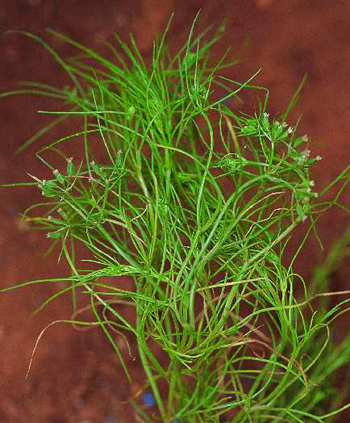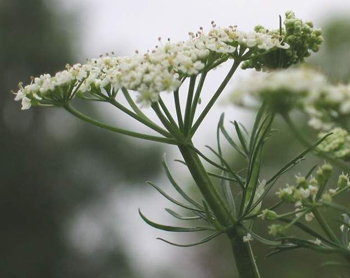Contents:
Common Names | Parts Usually Used | Plant(s) & Culture | Where Found | Medicinal Properties | Biochemical Information
Legends, Myths and Stories | Uses | Warning | Resource Links | Bibliography
Scientific Names

- Cuminum cyminum L.
- Umbelliferae
- Umbel family
Common Name
- Cumin
Parts Usually Used
Seeds
Back to Top

Description of Plant(s) and Culture
Cumin plants are low and sprawling because of the weak stems that will not support the weight of the large heads of the flowers and seed. This plant needs 4 months of warm weather and therefore, does not mature its seeds in the northern climates unless the plants are started indoors. When they are planted outside, the seed is sown 16 to 20 seeds per foot and plants are not thinned. A thick growth helps support the heavy heads of flowers and keeps them off the ground. This herb, as a member of the carrot family, has finely divided foliage and lavender-white flowers. The seeds ripen in late fall. When the heads begin to turn brown, they should be cut and dried indoors. When thoroughly dry, the heads are separated by rubbing between the hands. Seeds are small and separate from most of the chaff and stems by being strained through a sieve.
Back to Top
Where Found
Native to the eastern Mediterranean, especially the upper reaches of the Nile in Egypt.
Back to Top
Medicinal Properties
Antispasmodic, carminative, stimulant
Back to Top
Biochemical Information
Volatile oil comprised of cymol, cymene, and cuminic aldehyde
Back to Top
Legends, Myths and Stories
Cumin was known to the early Persians, Egyptians, and Hebrews. Its use followed civilization around the Mediterranean into France and England, though it has never become popular in the northern countries as it has been in the Near East. At one time, when pepper was rare and expensive, the Romans substituted cumin. In the time of Christ, the value of cumin had increased until it had become negotiable in payment of taxes.
Mentioned in the ancient Biblical writings and by Hippocrates and Dioscorides. In the Middle Ages, cumin was a very popular household medicine and spice. As a condiment, the seeds of cumin are still used mainly in Europe.
Cumin seeds are used in many Mexican dishes, exotic international dishes, and especially in East India cooking. In Trinidad, natives parch the seeds before using them in cooking.
The seeds are used to flavor bread, cookies, cheese, sausage, meats, vegetables, fish and game. Sometimes the seeds are used as an ingredient of curry powder or chili powder. Along with caraway, is used in the making of Kummel. In India, the seeds are used to flavor wine.
The seeds are similar to caraway seeds in appearance and flavor; though lighter in color, its flavor is stronger and less refined.
Cumin seed is said to attract animals, especially horses. The seeds rubbed on the hand and the hand passed over the nose of a horse, the horse becomes docile and will follow anywhere. Place a small amount on a sugar cube and give it to a horse to eat, or place on bait for catching wild animals, works wonderfully.
Back to Top
Uses
Used to treat digestive weakness, gas, bloat, colic, headache. Taken for coughs, colds. Externally, will hasten the healing of bruises and injuries.
Back to Top
Warning
Prolonged use of cumin in large quantities can result in a pale, wan complexion.
Back to Top
Resource Links
Herbs That are More Effective in Treating Lyme Than Antibiotics
Back to Top
Bibliography
![]() American Folk Medicine
American Folk Medicine, by Clarence Meyer, Meyerbooks, publisher, PO Box 427, Glenwood, Illinois 60425, 1973
![]() The Herbalist Almanac
The Herbalist Almanac, by Clarence Meyer, Meyerbooks, publisher, PO Box 427, Glenwood, Illinois 60425, copyright 1988, fifth printing, 1994
![]() The Herb Book
The Herb Book, by John Lust, Bantam Books, 666 Fifth Avenue, New York, NY. copyright 1974.
Herbal Gardening, compiled by The Robison York State Herb Garden, Cornell Plantations, Matthaei Botanical Gardens of the University of Michigan, University of California Botanical Garden, Berkeley., Pantheon Books, Knopf Publishing Group, New York, 1994, first edition
 Old Ways Rediscovered
Old Ways Rediscovered, by Clarence Meyer, Meyerbooks, publisher, PO Box 427, Glenwood, Illinois 60425, published from 1954, print 1988
![]() Planetary Herbology
Planetary Herbology, by Michael Tierra, C.A., N.D., O.M.D., Lotus Press, PO Box 325, Twin Lakes. WI 53181., Copyright 1988, published 1992
![]() The Yoga of Herbs: An Ayurvedic Guide to Herbal Medicine
The Yoga of Herbs: An Ayurvedic Guide to Herbal Medicine, by Dr. David Frawley & Dr. Vasant Lad, Lotus Press, Twin Lakes, Wisconsin, Second edition, 1988.
![]() Webster’s New World Dictionary
Webster’s New World Dictionary, Third College Edition, Victoria Neufeldt, Editor in Chief, New World Dictionaries: A Division of Simon & Schuster, Inc., 15 Columbus Circle, New York, NY 10023
 The Rodale Herb Book: How to Use, Grow, and Buy Nature’s Miracle Plants (An Organic gardening and farming book)
The Rodale Herb Book: How to Use, Grow, and Buy Nature’s Miracle Plants (An Organic gardening and farming book), edited by William H. Hylton, Rodale Press, Inc. Emmaus, PA, 18049., 1974
